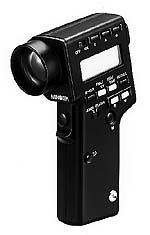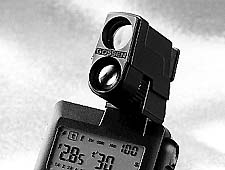
So why do so many photographers bother with separate hand-held exposure meters?
Why are there so many meters - some of them extremely sophisticated - on the market?
Why is the number of meters available increasing? And what does a separate meter give you that TTL doesn't or can't?
It is in incident light reading that a separate hand-held meter really scores. You measure the light falling on the subject rather than reflected from it, via a diffuser over the light-sensitive cell, with the meter at the subject position pointed towards the camera.
![]()
A typical incident light reading meter, the Sekonic Studio with its large plastic diffusing dome
An incident light reading will indicate the same exposure for both light-toned and darker subjects, and both will be correctly rendered as light and dark in the final image. The light on a distant subject will often will be exactly the same as light available near the camera, so there's rarely a need to walk backwards and forwards to take your readings.
The other use of an incident light meter is to measure lighting ratios in the studio.
If you want a 3:1 main-to-fill-in ratio, you take an incident reading from the main light only from the subject position, then from the fill-in only. Adjust the distance or power of the fill light until you get 1.5 stops difference between the two and you have your 3:1 ratio. Take an incident light reading with both lights on for the final exposure. Now try doing that with a built-in meter! Most current digital meters allow you to do this with the electronic flash itself rather than rely on modelling light ratios.
Separate meters have for many years been adaptable for incident light readings. My old Weston Master III, bought new in 1959 for the equivalent of $15.00, has an Invercone for incident light readings - and it's as accurate now as the day I bought it. But it won't, of course, read flash...
They do up to a point. The better systems are remarkably close to the accuracy of separate hand-held meters. The main difference, though, is one of size and readability.
A TTL meter reading may be a result of a calculation, already adjusted for what the camera's system considers is a non-standard subject. At the best it will be accurate to a third or half stop. Separate meters give a direct, unmodified reading and their scales have additional information like the over and under exposure points for common films, or an analogue scale accurate to one-tenth of a stop, should you ever need it.
The other big bonus that comes with reflected light meters is ease of use. It is quite easy to take various readings for a Zone System calculation from a small part of a tree-trunk near ground level with a hand-held meter, but that's quite difficult through a camera viewfinder. In addition, the scales or read-outs on separate meters make it much easier to work out corrections.

A typical spot meter, the Minolta Spotmeter IVF, which measures both flash and ambient light
A true spot meter such as the Minolta, Gossen or Pentax allows you to read very small areas of your subject from greater distances. Because these meters have a lens system, beware when taking a reading into the light. I find a home-made lens-shade of thin black card for my Pentax V spot meter essential.
The other thing to watch is interpretation of the readings you obtain - whatever you take your reading from will reproduce as a mid-tone if you don't adjust the indicated exposure to give the results you want.
The scales on spot meters also give a great deal of information besides a simple indication of exposure. Some allow you to take several readings, memorise and average them out to give the best compromise exposure. Others have an IRE (Institute of Radio Engineers) scale, normally used by TV cameramen to balance studio lighting, but also useful in controlling the overall contrast of a studio still shot.
Because the scales are quite large, it's easy to make your own supplementary scale to stick on. Mine has a zone scale that makes it easy to place readings on particular zones for the results I want, and Zone VI sell scales custom-made for various meters.

A spot-viewfinder attachment for the highly sensitive Gossen Mastersix meter
They can take readings by moonlight, can have true spot metering capabilities through add-on lens systems, can meter electronic flash and ambient in any combination, and allow precision to around a tenth of a stop, all powered by a single 1.5 volt battery.

The Aspen Corporation's Polaris meter
The L-408 is claimed to be the first weather-proof meter, and combines silicon photo-diode multi-flash, incident, reflected and spot measurement in a single unit. The meter has a built-in 5 degree viewfinder for semispot readings. This removes the inconvenience of having to carry and fit a spot converter/finder. There's a cover over the viewfinder lens to protect it when it's not in use.
A built-in diffusing Lumisphere is used for incident light; switchover is by a rotating mechanism and the Lumisphere retracts neatly into the body when not in use.
Shutter speed, aperture, EV and film speed are shown on a large LCD panel beside an analogue stop scale from f/1 to f/90 in half-stops, and a secondary one-stop display to tenth-stop precision. The Sekonic Multimaster L-408 retails at �400 GB pounds.
At just half that price, the Polaris offers all the functions of the Sekonic except spot. It has less range but higher sensitivity, from EV minus 4 to 26 as opposed to EV minus 0.9 to 36.1. The aperture range is slightly wider at f/0.5 to f/90, and the film speed range is the same at ISO 3 to ISO 8,000 in 1/3 stop increments.
Changing between reflected to incident is a matter of sliding a diffusor over, and between ambient, cord flash, and non-C flash is by repeatedly pushing a mode button.
The oversized LCD shows shutter speed and aperture, EV, and a single large analogue scale in tenth-stop and third-stop increments. A multi-flash feature calculates how many flashes you need to fire to achieve a desired f-stop.
The Polaris also has a Program Level feature that lets you calibrate the individual meter to your film and processing, by plus or minus one to nine tenths of a stop, similar to the little adjustment pot on the back of Minolta meters.
Both these meters are accurate, easy to use and value for money. If you don't need semi-spot metering, the Polaris is excellent value, while the spot facility of the L-408, plus its weatherproofing, is well worth the extra. Les McLean is taking the L-408 on his next wildnerness foray and will be letting us know how it survives rain, sea-spray, mud and sand.
The author's e-mail: [email protected]
Return to October contents